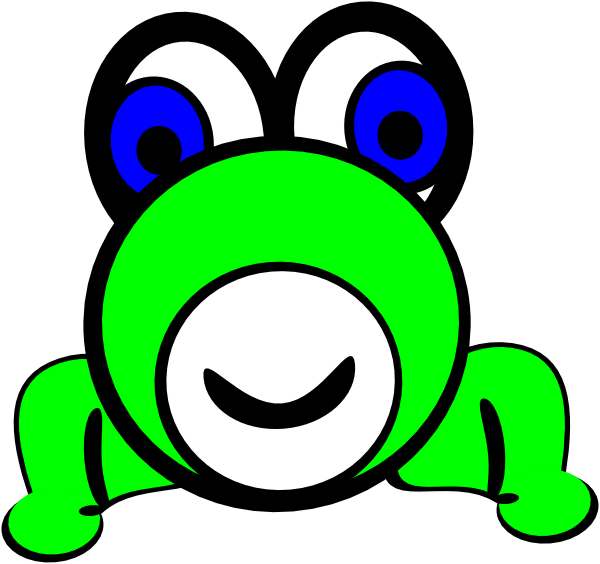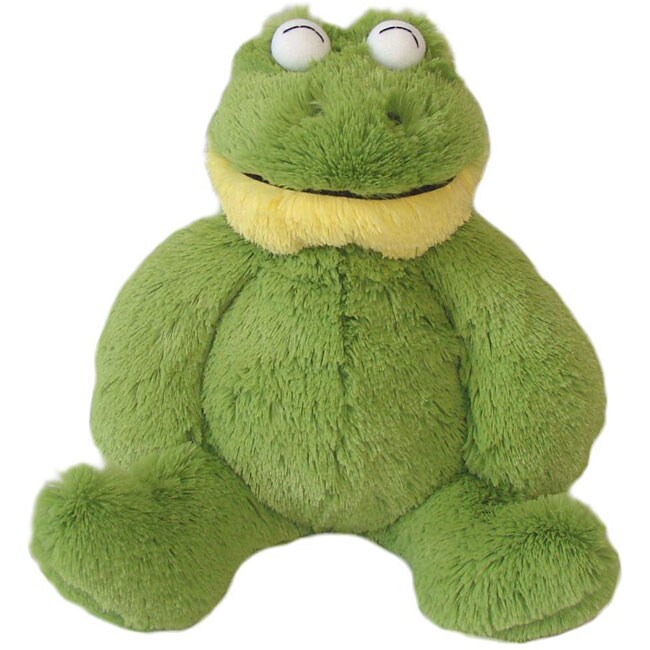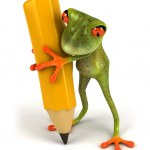Cartoon Frog Pictures Biography
Source(Google.com.pk)
Flip the Frog is an animated cartoon character created by American cartoonist Ub Iwerks. He starred in a series of cartoons produced by Celebrity Pictures and distributed through Metro-Goldwyn-Mayer from 1930 to 1933. The series had many recurring characters besides Flip; including Flip's dog, the mule Orace, and a dizzy neighborhood spinster.Flip was created by Ub Iwerks, animator for the Walt Disney Studios and a personal friend of Walt Disney in 1930, at the Iwerks Studios. After a series of disputes between the two, Iwerks left Disney and went on to accept an offer from Pat Powers to open a cartoon studio of his own and receive a salary of $300 a week, an offer that Disney couldn't match at the time. Iwerks was to produce new cartoons under Powers's Celebrity Pictures auspices and distributed by Metro-Goldwyn-Mayer. The first series he was to produce was to feature a character called Tony the Frog, but Iwerks disliked the name and it was subsequently changed to Flip.Flip's debut short was Fiddlesticks (released on August 16, 1930). Although the short looks to be very much like one of Iwerks's Silly Symphony endeavors, it attracted public attention by being the first color sound cartoon ever produced. The short was produced in two-color Technicolor and is the only Flip cartoon known to have been processed in color. However, some evidence indicates that the second Flip short, Flying Fists, may have been produced in Technicolor as well, and some have speculated that the later Techno-Cracked (1933) may have been photographed in Cinecolor. The Cinecolor process was a new two-strip color process that came out in 1932 and was considered superior to the two-strip Technicolor process. Iwerks would go on to make extensive use of this process with his ComiColor Cartoon series.Iwerks studio quickly began accumulating new talent, such as animators Fred Kopietz, Irv Spence, Grim Natwick, and Chuck Jones (who worked at the Iwerks studio as a cel-washer before going on to inbetweening and then animating at the Leon Schlesinger studio). After the first two cartoons, the appearance of Flip the Frog gradually became less froglike. This was done under the encouragement of MGM, who thought that the series would sell better if the character were more humanized. Flip's major redesign is attributed to Grim Natwick, who made a name for himself at the Fleischer Studios with the creation of Betty Boop. Natwick also had a hand in changing Flip's girlfriend. In earlier films, she was consistently a cat, but Natwick made Flip's new girlfriend, Fifi, a human who shared distinct similarities with Betty (even down to her spit curls).The frog's personality also began to develop. As the series progressed, Flip became more of a down-and-out, Chaplin-esque character who always found himself in everyday conflicts surrounding the poverty-stricken atmosphere of the Great Depression. Owing to the influx of New York City animators to Iwerks's studio, such as Natwick, the shorts became increasingly risqué. In Room Runners (1932), Flip, out of cash and luck, attempts to sneak out of his hotel in order to avoid paying his past-due rent. Another gag has Flip watch a girl taking a shower through a keyhole. In The Office Boy, released the same year, Flip tries to secure a low-level office job and meets a shapely secretary. At one point in the short, a mischievous mouse that Flip tries to apprehend scoots up the secretary's skirt. In A Chinaman's Chance (1933), Flip and his dog track down the notorious Chinese criminal Chow Mein. While investigating in a Chinese laundry, Flip stumbles into an opium den, inhales the stuff via opium pipe, and begins hallucinating.The character eventually wore out his welcome at MGM. His final short was Soda Squirt, released on October 12, 1933. Subsequently, Iwerks replaced the series with a new one starring an imaginative liar named Willie Whopper. Flip became largely forgotten by the public in the coming years. However, the character would make a small comeback when animation enthusiasts and historians began digging up the old Iwerks shorts. Most of the Flip cartoons are now available on DVD, in particular on the Cartoons That Time Forgot series.A character resembling Flip can be seen in one of the pictures in R.K. Maroon's office in the film Who Framed Roger Rabbit.In 1932, a Flip The Frog Annual was issued in England by Dean & Son Ltd. Published "by exclusive arrangement with Ub Iwerks, The Originator of The Film Character, Flip The Frog", it was drawn by Wilfred Haughton, who also drew the early Mickey Mouse Annuals for Deans. The Annual only ran for one edition, based on Flip's ending in 1933 and the lack of success with it. The earlier, more froglike character was used rather than the later version. The book contains 11 full cartoon strip stories, 4 colour plates and other one-page items that are not derived from any of his cartoons. All the adventures take place outside, unlike the cartoons, and feature additional characters, including a fox, a policeman, a girlfriend (Flap), an Uncle Flop (mentioned only), and others not shown in the cartoon films.Frogs are a diverse and largely carnivorous group of short-bodied, tailless amphibians composing the order Anura (Ancient Greek an-, without + oura, tail). The oldest fossil "proto-frog" appeared in the early Triassic of Madagascar, but molecular clock dating suggests their origins may extend further back to the Permian, 265 million years ago. Frogs are widely distributed, ranging from the tropics to subarctic regions, but the greatest concentration of species diversity is found in tropical rainforests. There are approximately 4,800 recorded species, accounting for over 85% of extant amphibian species. They are also one of the five most diverse vertebrate orders.The body plan of an adult frog is generally characterized by a stout body, protruding eyes, cleft tongue, limbs folded underneath and the absence of a tail. Besides living in fresh water and on dry land, the adults of some species are adapted for living underground or in trees. The skin of the frog is glandular, with secretions ranging from distasteful to toxic. Warty species of frog tend to be called toads. Frog warts are elevations in the skin where glandular toxins tend to concentrate. The distinction between frogs and toads is based on informal naming conventions concentrating on the warts rather than taxonomy or evolutionary history; some toads are more closely related to frogs than other toads. Frogs' skins vary in colour from well-camouflaged dappled brown, grey and green to vivid patterns of bright red or yellow and black to advertise toxicity and warn off predators.Frogs typically lay their eggs in water. The eggs hatch into aquatic larvae, called tadpoles, that have tails and internal gills. They have highly specialized rasping mouth parts suitable for herbivorous, omnivorous or planktivorous diets. The life cycle is completed when they metamorphose into adults. A few species deposit eggs on land or bypass the tadpole stage. Adult frogs generally have a carnivorous diet consisting of small invertebrates, but omnivorous species exist and a few feed on fruit. Frogs are extremely efficient at converting what they eat into body mass, which makes them an important food source for predators. Frogs are a keystone group in the food web dynamics of many of the world's ecosystems. The skin is semi-permeable, making them susceptible to dehydration, so they either live in moist places or have special adaptations to deal with dry habitats. Frogs produce a wide range of vocalizations, particularly in their breeding season, and exhibit many different kinds of complex behaviours to attract mates, to fend off predators and to generally survive.Frog populations have declined significantly since the 1950s. More than one third of species are considered to be threatened with extinction and over one hundred and twenty are believed to have become extinct since the 1980s.[1] The number of malformations among frogs is on the rise and an emerging fungal disease, chytridiomycosis, has spread around the world. Conservation biologists are working to understand the causes of these problems and to resolve them. Frogs are valued as food by humans and also have many cultural roles in literature, symbolism and religion.
Source(Google.com.pk)
Flip the Frog is an animated cartoon character created by American cartoonist Ub Iwerks. He starred in a series of cartoons produced by Celebrity Pictures and distributed through Metro-Goldwyn-Mayer from 1930 to 1933. The series had many recurring characters besides Flip; including Flip's dog, the mule Orace, and a dizzy neighborhood spinster.Flip was created by Ub Iwerks, animator for the Walt Disney Studios and a personal friend of Walt Disney in 1930, at the Iwerks Studios. After a series of disputes between the two, Iwerks left Disney and went on to accept an offer from Pat Powers to open a cartoon studio of his own and receive a salary of $300 a week, an offer that Disney couldn't match at the time. Iwerks was to produce new cartoons under Powers's Celebrity Pictures auspices and distributed by Metro-Goldwyn-Mayer. The first series he was to produce was to feature a character called Tony the Frog, but Iwerks disliked the name and it was subsequently changed to Flip.Flip's debut short was Fiddlesticks (released on August 16, 1930). Although the short looks to be very much like one of Iwerks's Silly Symphony endeavors, it attracted public attention by being the first color sound cartoon ever produced. The short was produced in two-color Technicolor and is the only Flip cartoon known to have been processed in color. However, some evidence indicates that the second Flip short, Flying Fists, may have been produced in Technicolor as well, and some have speculated that the later Techno-Cracked (1933) may have been photographed in Cinecolor. The Cinecolor process was a new two-strip color process that came out in 1932 and was considered superior to the two-strip Technicolor process. Iwerks would go on to make extensive use of this process with his ComiColor Cartoon series.Iwerks studio quickly began accumulating new talent, such as animators Fred Kopietz, Irv Spence, Grim Natwick, and Chuck Jones (who worked at the Iwerks studio as a cel-washer before going on to inbetweening and then animating at the Leon Schlesinger studio). After the first two cartoons, the appearance of Flip the Frog gradually became less froglike. This was done under the encouragement of MGM, who thought that the series would sell better if the character were more humanized. Flip's major redesign is attributed to Grim Natwick, who made a name for himself at the Fleischer Studios with the creation of Betty Boop. Natwick also had a hand in changing Flip's girlfriend. In earlier films, she was consistently a cat, but Natwick made Flip's new girlfriend, Fifi, a human who shared distinct similarities with Betty (even down to her spit curls).The frog's personality also began to develop. As the series progressed, Flip became more of a down-and-out, Chaplin-esque character who always found himself in everyday conflicts surrounding the poverty-stricken atmosphere of the Great Depression. Owing to the influx of New York City animators to Iwerks's studio, such as Natwick, the shorts became increasingly risqué. In Room Runners (1932), Flip, out of cash and luck, attempts to sneak out of his hotel in order to avoid paying his past-due rent. Another gag has Flip watch a girl taking a shower through a keyhole. In The Office Boy, released the same year, Flip tries to secure a low-level office job and meets a shapely secretary. At one point in the short, a mischievous mouse that Flip tries to apprehend scoots up the secretary's skirt. In A Chinaman's Chance (1933), Flip and his dog track down the notorious Chinese criminal Chow Mein. While investigating in a Chinese laundry, Flip stumbles into an opium den, inhales the stuff via opium pipe, and begins hallucinating.The character eventually wore out his welcome at MGM. His final short was Soda Squirt, released on October 12, 1933. Subsequently, Iwerks replaced the series with a new one starring an imaginative liar named Willie Whopper. Flip became largely forgotten by the public in the coming years. However, the character would make a small comeback when animation enthusiasts and historians began digging up the old Iwerks shorts. Most of the Flip cartoons are now available on DVD, in particular on the Cartoons That Time Forgot series.A character resembling Flip can be seen in one of the pictures in R.K. Maroon's office in the film Who Framed Roger Rabbit.In 1932, a Flip The Frog Annual was issued in England by Dean & Son Ltd. Published "by exclusive arrangement with Ub Iwerks, The Originator of The Film Character, Flip The Frog", it was drawn by Wilfred Haughton, who also drew the early Mickey Mouse Annuals for Deans. The Annual only ran for one edition, based on Flip's ending in 1933 and the lack of success with it. The earlier, more froglike character was used rather than the later version. The book contains 11 full cartoon strip stories, 4 colour plates and other one-page items that are not derived from any of his cartoons. All the adventures take place outside, unlike the cartoons, and feature additional characters, including a fox, a policeman, a girlfriend (Flap), an Uncle Flop (mentioned only), and others not shown in the cartoon films.Frogs are a diverse and largely carnivorous group of short-bodied, tailless amphibians composing the order Anura (Ancient Greek an-, without + oura, tail). The oldest fossil "proto-frog" appeared in the early Triassic of Madagascar, but molecular clock dating suggests their origins may extend further back to the Permian, 265 million years ago. Frogs are widely distributed, ranging from the tropics to subarctic regions, but the greatest concentration of species diversity is found in tropical rainforests. There are approximately 4,800 recorded species, accounting for over 85% of extant amphibian species. They are also one of the five most diverse vertebrate orders.The body plan of an adult frog is generally characterized by a stout body, protruding eyes, cleft tongue, limbs folded underneath and the absence of a tail. Besides living in fresh water and on dry land, the adults of some species are adapted for living underground or in trees. The skin of the frog is glandular, with secretions ranging from distasteful to toxic. Warty species of frog tend to be called toads. Frog warts are elevations in the skin where glandular toxins tend to concentrate. The distinction between frogs and toads is based on informal naming conventions concentrating on the warts rather than taxonomy or evolutionary history; some toads are more closely related to frogs than other toads. Frogs' skins vary in colour from well-camouflaged dappled brown, grey and green to vivid patterns of bright red or yellow and black to advertise toxicity and warn off predators.Frogs typically lay their eggs in water. The eggs hatch into aquatic larvae, called tadpoles, that have tails and internal gills. They have highly specialized rasping mouth parts suitable for herbivorous, omnivorous or planktivorous diets. The life cycle is completed when they metamorphose into adults. A few species deposit eggs on land or bypass the tadpole stage. Adult frogs generally have a carnivorous diet consisting of small invertebrates, but omnivorous species exist and a few feed on fruit. Frogs are extremely efficient at converting what they eat into body mass, which makes them an important food source for predators. Frogs are a keystone group in the food web dynamics of many of the world's ecosystems. The skin is semi-permeable, making them susceptible to dehydration, so they either live in moist places or have special adaptations to deal with dry habitats. Frogs produce a wide range of vocalizations, particularly in their breeding season, and exhibit many different kinds of complex behaviours to attract mates, to fend off predators and to generally survive.Frog populations have declined significantly since the 1950s. More than one third of species are considered to be threatened with extinction and over one hundred and twenty are believed to have become extinct since the 1980s.[1] The number of malformations among frogs is on the rise and an emerging fungal disease, chytridiomycosis, has spread around the world. Conservation biologists are working to understand the causes of these problems and to resolve them. Frogs are valued as food by humans and also have many cultural roles in literature, symbolism and religion.
Images Pics Photos Wallpapers Pictures
Images Pics Photos Wallpapers Pictures
Images Pics Photos Wallpapers Pictures
Images Pics Photos Wallpapers Pictures
Images Pics Photos Wallpapers Pictures
Images Pics Photos Wallpapers Pictures
Images Pics Photos Wallpapers Pictures
Images Pics Photos Wallpapers Pictures
Images Pics Photos Wallpapers Pictures
Images Pics Photos Wallpapers Pictures










No comments:
Post a Comment